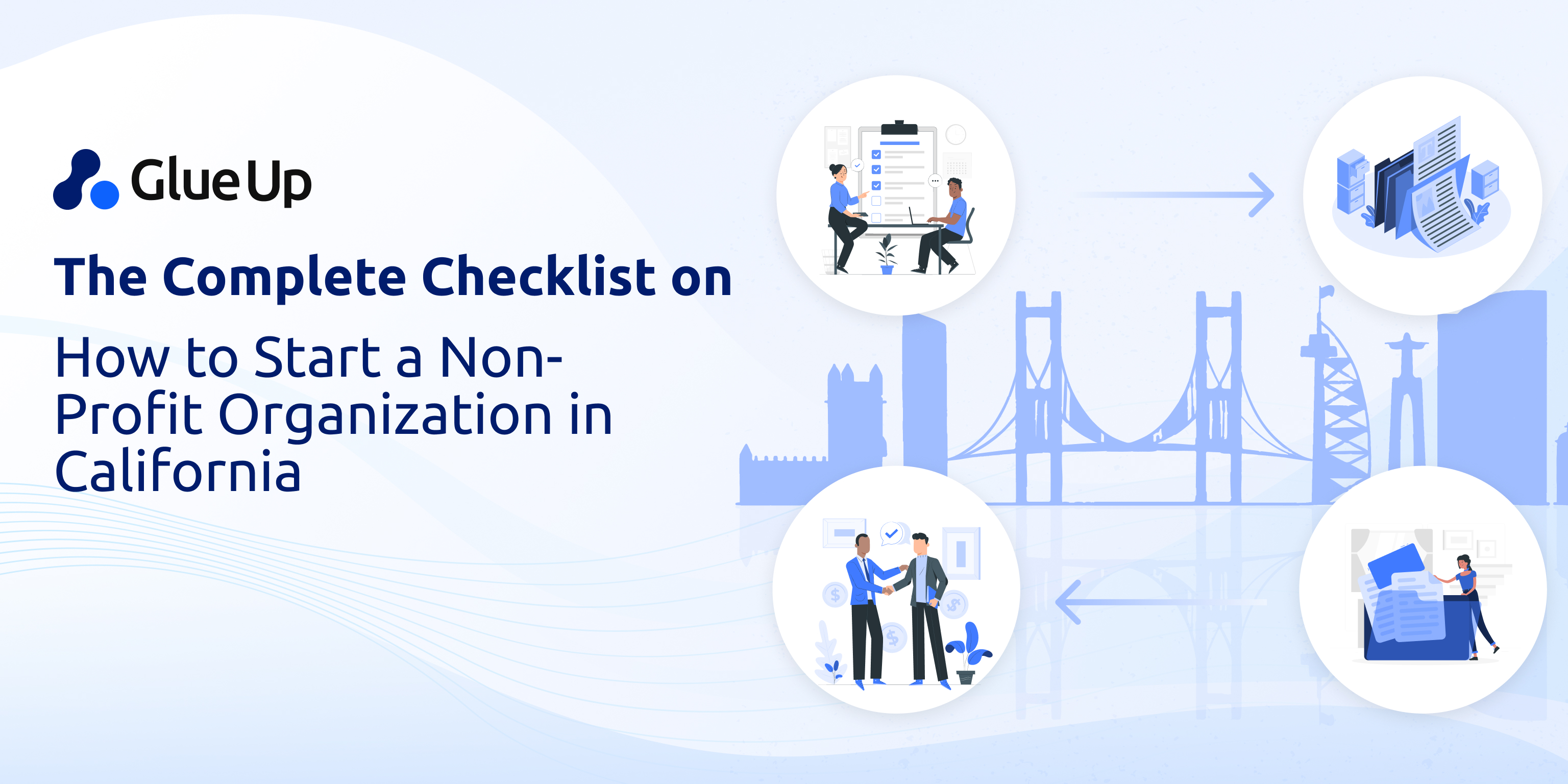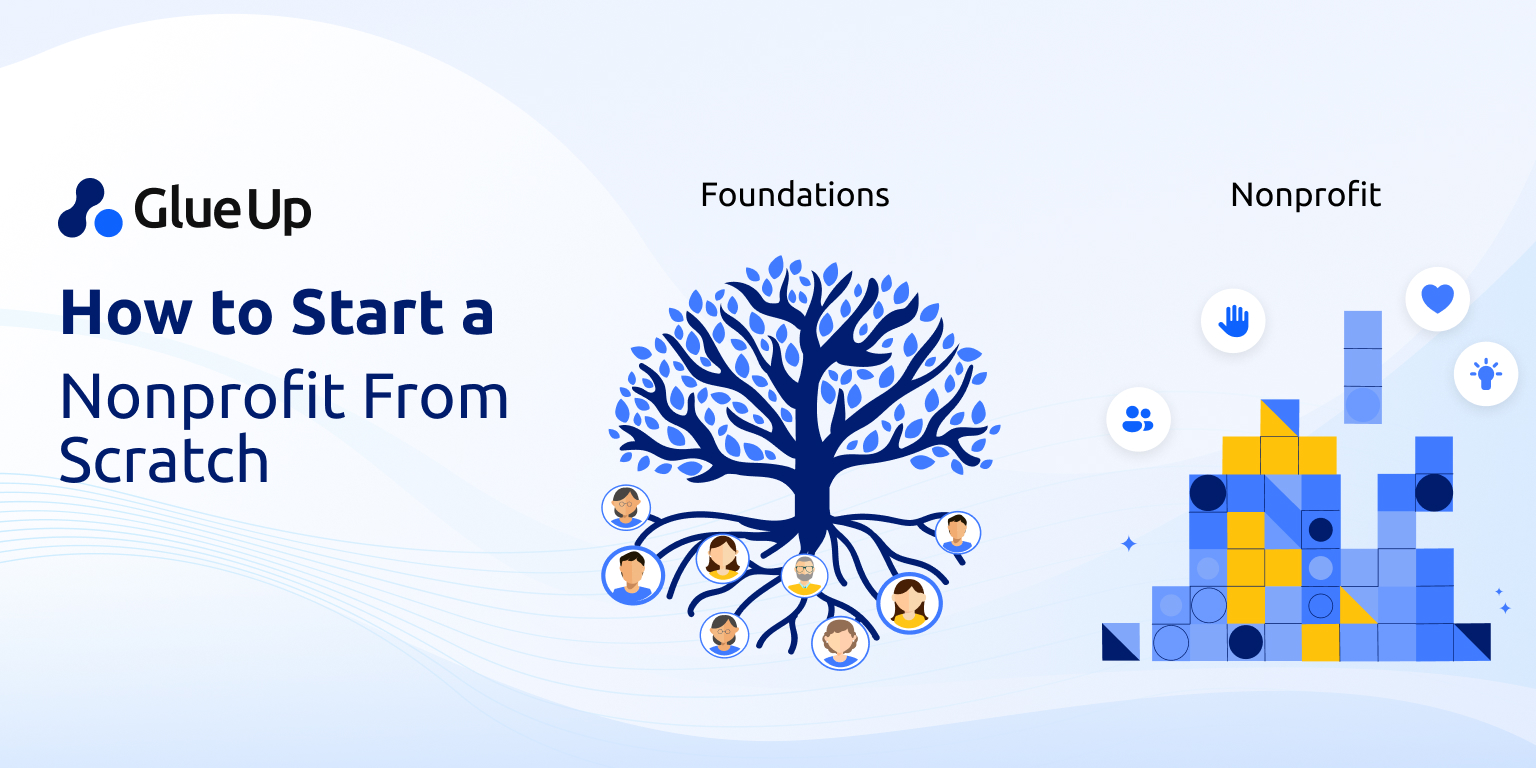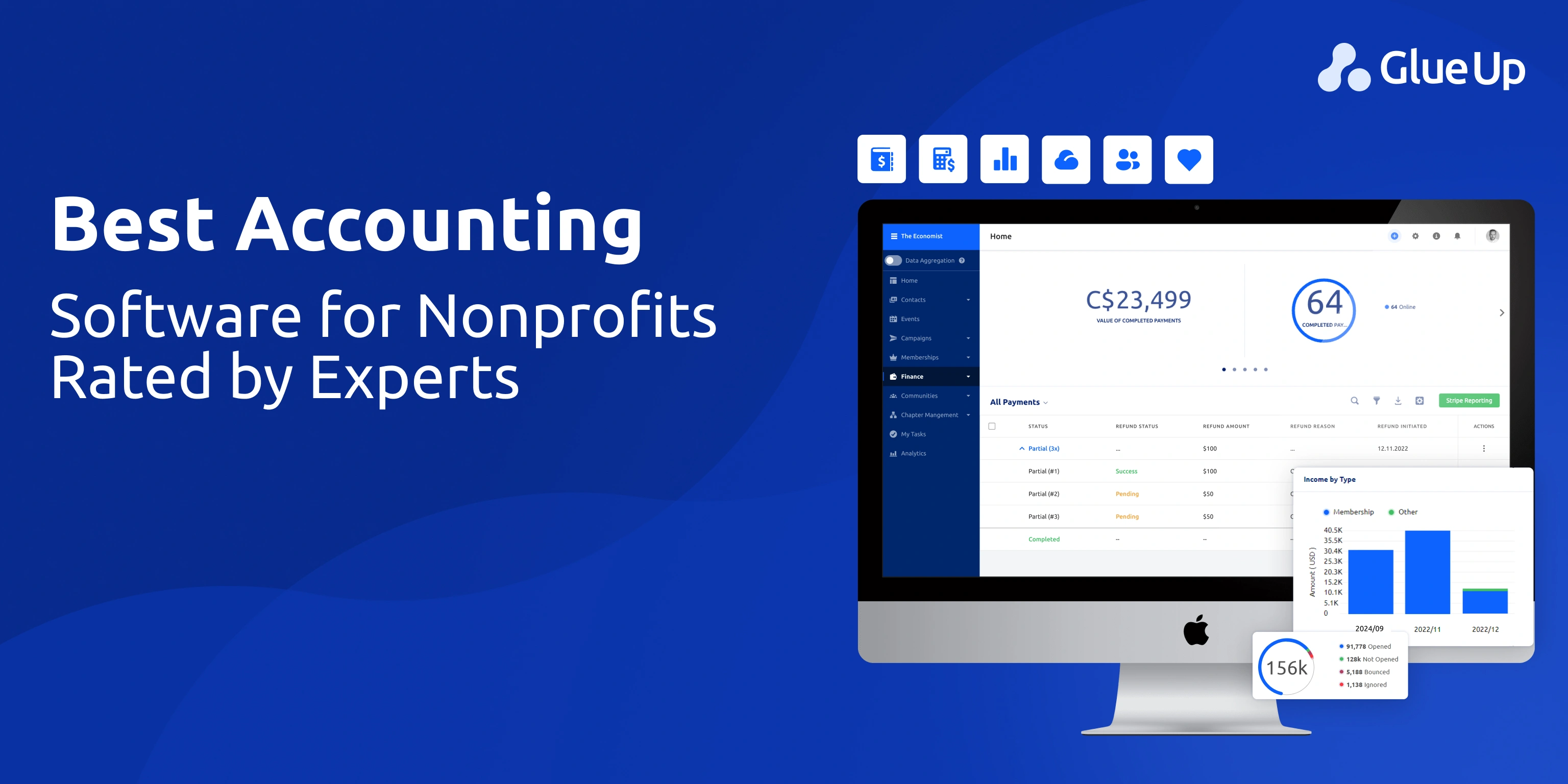
You are ready to build something real. You have a mission, people who believe in it, and a list of communities that will benefit if you move. The question sitting in front of you is simple and big at the same time: How to Start a Non Profit Organization in California without guesswork, delays, or messy surprises.
This guide gives you the straight path. It covers the legal shell, tax exemption, Attorney General filings, first-year weekly and monthly actions, and the operating habits that keep you credible with members, funders, and your board. You will also see how the administrative side connects to outcomes you can measure when you run memberships, events, and payments in Glue Up.
Read this like a field guide. Copy the steps. Borrow the calendar. Share it with your team. When someone asks you how to start a non profit organization in California, you will have a sequence that works in the real world.
Key Takeaways
Form a California nonprofit public benefit corporation, adopt bylaws, get an EIN, apply for IRS exemption, file FTB 3500A or 3500, register with the Attorney General within 30 days of first assets, file SI 100 within 90 days, then file RRF 1 with the 990 each year, and SI 100 every two years.
Build a 12-month schedule that assigns who files what and when, keeps documents in one place, and prevents penalties, suspensions, or fundraising limits.
Get a seller’s permit if you sell taxable items, separate taxable lines in checkout, register with EDD as soon as wages exceed the small threshold in a quarter, and use proper payroll and records.
Register and report charitable raffles, verify commercial fundraisers and counsel, and send receipts and acknowledgments that clearly state what is and is not tax deductible.
Use Glue Up for memberships, events, payments, emails, community, mobile approvals, and AI assisted drafting, so your renewals, filings, and board reports pull from the same accurate data.
Quick Reads
Choose Your Legal Shell for How to Start a Non Profit Organization in California
Pick the structure that fits your mission and funding model. For most community-serving groups, that is a California nonprofit public benefit corporation. It gives you a clear governance model, limited liability, and a familiar setup for banks, fiscal sponsors, and grantmakers. File your Articles of Incorporation using the state’s template that already contains the purpose and dissolution language the IRS expects. That one detail saves weeks later.
Three tasks to finish this stage with confidence:
Name check and reserve if needed. Avoid names that are too close to existing charities. Simple names age well and prevent confusion.
Articles that match your intended IRS status. If you plan to seek 501(c)(3), keep the charitable purpose tight and include the asset dedication clause.
Plan the first organizational meeting. You will adopt bylaws, seat directors, and record minutes. Put that date on the calendar now.
Tip for operators: set your fiscal year before you file anything else in your binder. Pick the month that aligns with your programs and grant cycles.
Adopt Bylaws and Seat the Board for How to Start a Non Profit Organization in California
Bylaws are not just a form. They are the working rules that prevent drama later. Keep them clean and readable. If you cannot explain a clause in one sentence, rewrite it.
What to include without fluff:
Board size and terms. Odd numbers prevent tie votes. Stagger terms to keep continuity.
Officers and duties. Chair, treasurer, secretary. Write clear responsibilities so meetings run on time and financials stay accurate.
Meeting cadence and quorum. Monthly for the first year is a smart default. You will have real decisions to make.
Conflict of interest policy. Make disclosures normal. Keep a one-page annual form on file.
Committees with purpose. Only create committees that have clear tasks and deadlines.
Close the meeting properly. Approve minutes on the spot. Assign action items. Capture the vote that authorizes opening a bank account. File everything in a records binder you can hand to a new treasurer without a tour.
Secure Your EIN And Banking for How to Start a Non Profit Organization in California
Apply for your federal Employer Identification Number online. It is free and instant. Use your Articles information exactly as filed. Then open your bank account with your Articles, EIN letter, bylaws, and the board resolution. Set dual controls from day one. Require two signatures for wires and checks above a sensible threshold. Use separate accounts for general operations and restricted funds so program reporting is not a puzzle at year-end.
While you are in setup mode, pick one card for predictable expenses and one for travel. Keep all receipts digital. Later, when you prepare your first 990 or state reports, you will be grateful you were strict at the start.
Win Federal Tax-Exempt Status For How to Start a Non Profit Organization in California
This is where many groups stall. Do not. Choose the right IRS application, prepare like a pro, and submit a complete package.
Form 1023-EZ is for small, simple organizations that meet the IRS worksheet tests. If your projected revenue is modest and your activities are straightforward, the EZ route is faster and cheaper.
Form 1023 (standard) is for everyone else. It asks for a narrative of activities, budgets, compensation details, and your governing documents.
What to prepare either way:
Plain language program descriptions. Describe what you do, who benefits, and how you will measure results in one paragraph per program.
First 3-year budgets. Show revenue sources, not wish lists. If you plan events or membership dues, say so.
Policies that matter. Conflict of interest, document retention, reimbursement, and gift acceptance if you will receive non-cash items.
File electronically, pay the user fee, and watch for follow-up questions. If the IRS asks for clarity, answer directly and attach supporting pages, not stories.
Activate State Income-Tax Exemption for How to Start a Non Profit Organization in California
Federal status opens the door. State status keeps California income tax off your charitable revenue. If you receive your IRS determination letter, file the short state form to recognize that exemption in California. If you do not yet have the federal letter or you fit a category the short form does not cover, use the longer application with your bylaws, Articles, and program details.
Why this matters even if your budget is small:
Some funders require proof of both federal and state exemption.
It saves confusion when filing state returns.
It keeps your records consistent across agencies.
Put the state letter in the same binder as your IRS letter. You will attach both to filings and grant applications again and again.
Register With the Attorney General for How to Start a Non Profit Organization in California
California treats charitable assets as a public trust. That means you register with the Attorney General’s Registry of Charitable Trusts once you start receiving donations, grants, or donated property. The initial registration is not hard. The timing is strict. The rule of thumb: once the first dollars or donated items hit your account, your 30-day clock starts.
What you submit:
Initial registration form with your Articles and bylaws
IRS letter if you have it
First-year budget or financials if available
Why boards should care:
You cannot represent that you are in good standing with donors or partners if the registry shows you as unregistered or delinquent.
Late filings can trigger penalties and fundraising limits. Avoid that noise entirely with a calendar you actually follow.
File Your Statement of Information for How to Start a Non Profit Organization in California
There is one more state step people forget. Your Statement of Information with the Secretary of State is due within 90 days after you file Articles, then every two years. It is short. It lists your officers, address, and agent for service of process. Missing it means late fees and public records that do not match reality. Put it on the same calendar as your IRS and Attorney General deadlines.
Best practice for smooth updates:
Use a generic admin email as your public contact, not a personal account.
If your board turns over, update the statement right after elections.
Handle Sales and Use Tax for How to Start a Non Profit Organization in California
Many new nonprofits think federal, and state income-tax exemption means no sales tax. California does not work that way. If you sell merchandise, charge for certain items at events, or run ongoing sales activity, you likely need a seller’s permit with the state tax agency. For occasional events, you may qualify for a temporary permit, but you still need to register. Read the nonprofit guide from the tax agency, decide how you will track taxable sales, and build that into your event workflows.
Practical tips:
Separate taxable items in your checkout process so reporting is easy.
If you offer member discounts, make sure the point-of-sale tool applies tax correctly after the discount.
Keep copies of resale certificates from vendors if you buy items for resale.
Register As an Employer If You Hire for How to Start a Non Profit Organization in California
All it takes is a small payroll to create obligations with the state employment department. Once you pay above a low threshold in a calendar quarter, you register, withhold, and file returns. Even if you only hire one part-time coordinator, set this up the right way. Use a reputable payroll service. Elect the financing option for unemployment insurance that fits a 501(c)(3). Keep your worker classifications clean. Your first audit should be boring.
Checklist for your first hire:
Offer letter with clear duties and pay
Form I-9 and W-4 on file
New hire report submitted on time
Posters and notices available digitally
Written expense reimbursement policy
Plan Special Fundraising Activities for How to Start a Non Profit Organization in California
Raffles are popular. They also have their own rules. If you plan one, register for the charitable raffle season and submit the annual report. If you hire a commercial fundraiser or fundraising counsel, check their registration and file your contract when required. These details are not just formalities. They protect your reputation with donors and keep your AG record clean.
Better fundraising habits:
Publish clear rules for raffles and drawings
Use numbered tickets and reconcile inventory
Deposit funds promptly and keep separate records for restricted gifts
Build Your First-Year Compliance Calendar for How to Start a Non Profit Organization in California
Now pull the steps together and put them on dates you can follow. Use this starter schedule and adjust to your fiscal year. If you choose a June year-end, your dates shift, but the sequence holds.
Month 0
File Articles
Schedule the organizational meeting
Draft bylaws and basic policies
Month 1
Hold the organizational meeting
Adopt bylaws and elect officers
Apply for EIN and open banking
Approve your fiscal year
Month 2
Prepare and file your IRS exemption application
Register with the Attorney General if assets already received
Prepare your Statement of Information
By Day 90
File your Statement of Information with the Secretary of State
After IRS Letter
Submit your California state income-tax exemption recognition
Each Quarter If Hiring
Run payroll, file returns, and pay withholdings
Each Program Cycle
If selling goods or taxable items, reconcile sales tax and file returns
Four Months And 15 Days After Fiscal Year End
File your annual Attorney General renewal with the correct financial attachment
File your IRS 990 series return and any state return due
Every Two Years
File your Statement of Information again in your assigned window
Put all of this in one place your team can see. If your tools can generate reminders and store confirmations, use them. That is how you avoid the classic “we thought someone else filed it” conversation.
Run Operations Like a Grown Organization for How to Start a Non Profit Organization in California
Formation is step one. Running the organization well is what members, sponsors, and funders see every day. You can keep that tight with habits that are simple to repeat.
Memberships that make sense
Create levels that match real value. If you serve individuals, keep tiers understandable and set renewal dates that match program cycles. If you serve companies, define seats, benefits, and who can transfer them. Automate renewals with friendly reminders and grace periods that are humane but firm. Every renewal you save is an hour you do not spend chasing checks.
Events that feel worth the time
Your event registration page should read like a promise. Outcome-focused headline. Who it is for. Date, time, and time zone. Short form. Button that says exactly what happens next. If you offer multiple ticket types, explain the differences in one line each. Send confirmations instantly. Send reminders on a schedule. If your events include taxable items, configure tax handling once and reuse it.
Receipts and acknowledgments that build trust
Members and donors do not need long letters. They need receipts with the right details: amount, date, what is and is not tax-deductible, and a thank you that feels like a person wrote it. Save your templates, pull the data, and send on time. At year-end, batch statements help people file taxes and remember you when the next budget cycle starts.
Community you can point to
Between events, keep a steady beat. Share wins, member stories, and opportunities. Invite useful replies. Quiet spaces matter, but silence erodes value. Use member profiles and tags so conversations stay relevant. When your board asks about engagement, show metrics that match your mission instead of raw counts that do not mean much.
Put It All on Rails with Glue Up for How to Start a Non Profit Organization in California
You can do all of the above with spreadsheets and willpower. You can also make it easier on your team.
Membership management keeps dues schedules, renewals, and receipts consistent. You can see who is active, who is late, and who needs a nudge today.
Event management builds branded pages, ticket types, add-ons, and promo codes. Attendee data lands where you need it for reports and outreach.
Payments and invoicing give you a single place to reconcile revenue for your 990 and state filings. Refunds and adjustments live in the same timeline as original transactions.
Email and marketing automation send confirmations, reminders, and renewal notices tied to roles, interests, or engagement patterns.
Community gives members a reason to return between events. They can ask questions, share resources, and connect around topics that matter.
AI Copilot helps you draft subject lines, reminders, and policy notes in your voice. It will not file your 990, but it will save hours each month.
Mobile apps let staff approve applications and renewals on the go. Members can RSVP, pay, and check in from their phones.
Glue Up becomes your operating spine. When someone asks for a report, you can export clean lists and summaries that match your filings. When a sponsor asks about attendance and follow-up, you can show both. When your board asks if the organization is ready for growth, you can say yes because your house is in order.
Mistakes To Avoid When You Think About How to Start a Non Profit Organization in California
Waiting to register with the Attorney General until year-end
Once you receive charitable assets, the clock is running. File the initial registration promptly. Staying current avoids penalties and unlocks fundraising confidence.
Ignoring sales tax because you are a charity
If you sell items, you likely need a seller’s permit, and you must collect and remit tax when required. Build that into your event and store setup.
Treating bylaws like boilerplate
Write rules you can live with. Make meeting schedules realistic. Keep conflicts disclosed and minutes tight. Short, clear bylaws are easier to follow than long, vague ones.
Letting email be the only system
Inbox confirmations vanish. Put your receipts, approvals, and renewals in a system that can pull reports and export data for forms. Future you will thank present you.
Underestimating the first hire
Even small payrolls create rules. Set it up cleanly. Use a payroll service. Keep files current. A little structure now saves pain later.
Frequently Asked Questions on How to Start a Non Profit Organization in California
How long does it take to receive 501(c)(3) recognition?
It varies with workload and completeness. Small, simple cases using the streamlined application often move faster. Complex programs, larger budgets, or missing attachments add time. You control the quality of your first submission.
Do all California nonprofits file with the Attorney General every year?
Almost all charities do. Your annual renewal includes a short form and a financial attachment that matches your federal return type. Keep this on the same calendar as your 990 to avoid slips.
Is there a fee to file Articles for a nonprofit?
There is a filing fee for Articles and a small fee for the Statement of Information. Budget for those, your IRS user fee, and routine costs like a registered agent if you use one.
Can a California nonprofit sell merchandise without collecting sales tax?
Not by default. If you sell taxable items, you generally need a seller’s permit and you collect and remit as the rules require. Occasional sales may have special handling, but do not assume exemption.
What happens if we miss the Statement of Information deadline?
You pay a late fee and your public record shows as delinquent until you catch up. Fix it quickly and put the next biennial due date on your calendar with two reminders.
Your Next Three Moves for How to Start a Non Profit Organization in California
Put dates on paper. Take the first-year calendar above and add it to your team’s planner. Assign owners for each filing.
Decide on your operating system. If Glue Up will run memberships, events, payments, and messages, set it up now so your first receipts and renewals are already clean.
Teach the board the sequence. Print a one-page version of this guide. When everyone knows the order, decisions speed up and compliance sticks.
Starting a nonprofit is not about perfect paperwork. It is about building trust in public. When people ask you how to start a non profit organization in California, show them a plan that matches your values: clear, steady, and accountable.
Put structure in place that lets your team focus on the work members feel. Keep your records clean so funders and sponsors can say yes without hesitation. And when you are ready to make the admin side easy on yourself, bring it all together in Glue Up so your mission gets the time it deserves.



